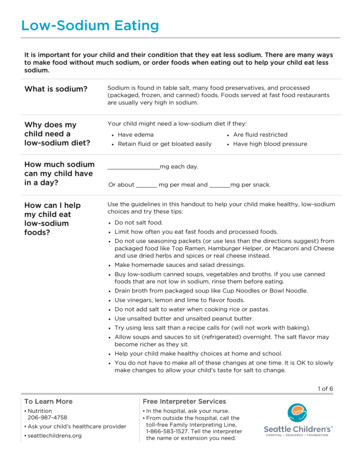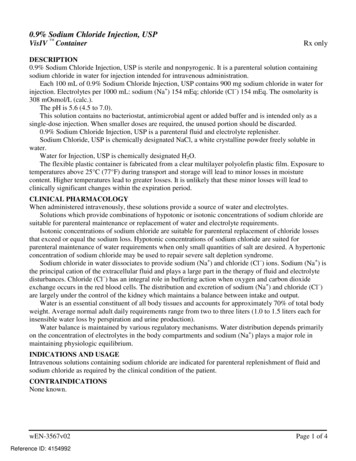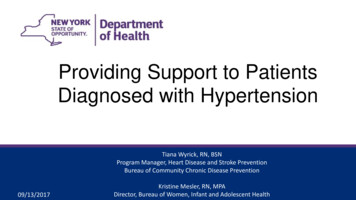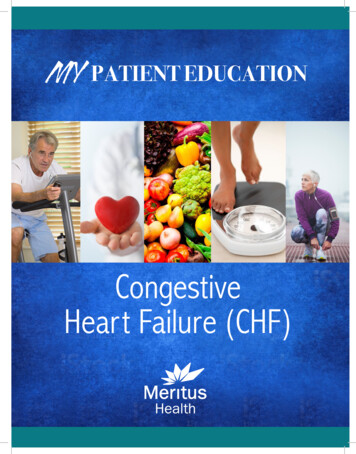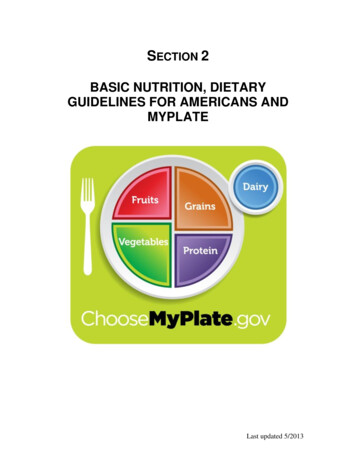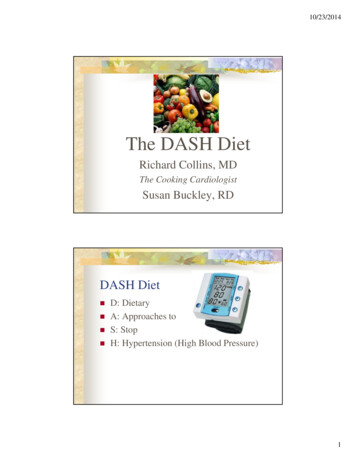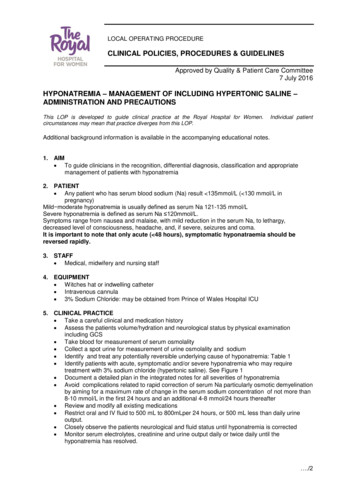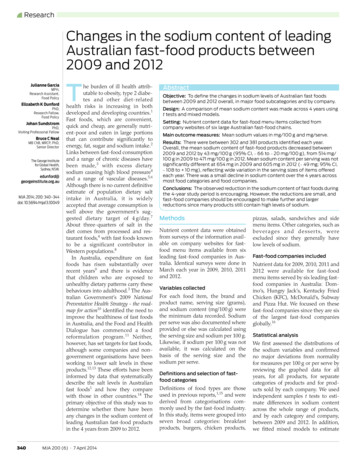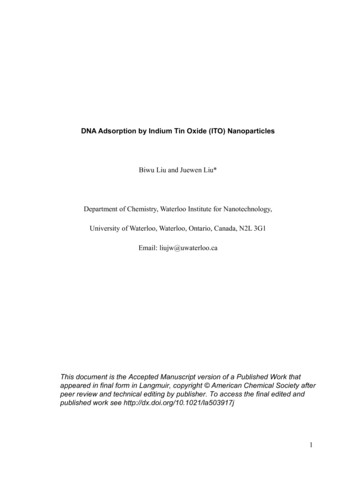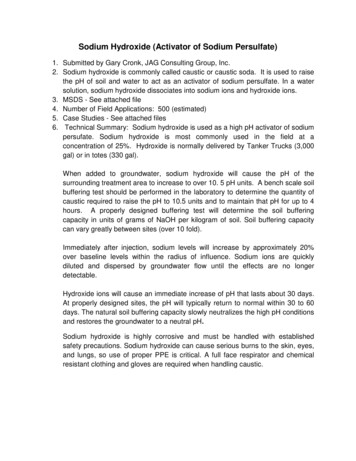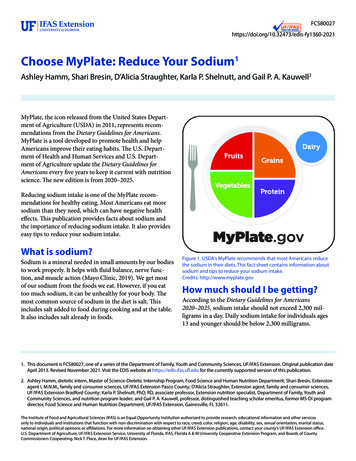
Transcription
hoose MyPlate: Reduce Your Sodium1Ashley Hamm, Shari Bresin, D’Alicia Straughter, Karla P. Shelnutt, and Gail P. A. Kauwell2MyPlate, the icon released from the United States Department of Agriculture (USDA) in 2011, represents recommendations from the Dietary Guidelines for Americans.MyPlate is a tool developed to promote health and helpAmericans improve their eating habits. The U.S. Department of Health and Human Services and U.S. Department of Agriculture update the Dietary Guidelines forAmericans every five years to keep it current with nutritionscience. The new edition is from 2020–2025.Reducing sodium intake is one of the MyPlate recommendations for healthy eating. Most Americans eat moresodium than they need, which can have negative healtheffects. This publication provides facts about sodium andthe importance of reducing sodium intake. It also provideseasy tips to reduce your sodium intake.What is sodium?Sodium is a mineral needed in small amounts by our bodiesto work properly. It helps with fluid balance, nerve function, and muscle action (Mayo Clinic, 2019). We get mostof our sodium from the foods we eat. However, if you eattoo much sodium, it can be unhealthy for your body. Themost common source of sodium in the diet is salt. Thisincludes salt added to food during cooking and at the table.It also includes salt already in foods.Figure 1. USDA’s MyPlate recommends that most Americans reducethe sodium in their diets. This fact sheet contains information aboutsodium and tips to reduce your sodium intake.Credits: http://www.myplate.govHow much should I be getting?According to the Dietary Guidelines for Americans2020–2025, sodium intake should not exceed 2,300 milligrams in a day. Daily sodium intake for individuals ages13 and younger should be below 2,300 milligrams.1. This document is FCS80027, one of a series of the Department of Family, Youth and Community Sciences, UF/IFAS Extension. Original publication dateApril 2013. Revised November 2021. Visit the EDIS website at https://edis.ifas.ufl.edu for the currently supported version of this publication.2. Ashley Hamm, dietetic intern, Master of Science-Dietetic Internship Program, Food Science and Human Nutrition Department; Shari Bresin, Extensionagent I, M.N.M., family and consumer sciences, UF/IFAS Extension Pasco County; D’Alicia Straughter, Extension agent, family and consumer sciences,UF/IFAS Extension Bradford County; Karla P. Shelnutt, PhD, RD, associate professor, Extension nutrition specialist, Department of Family, Youth andCommunity Sciences, and nutrition program leader; and Gail P. A. Kauwell, professor, distinguished teaching scholar emeritus, former MS-DI programdirector, Food Science and Human Nutrition Department; UF/IFAS Extension, Gainesville, FL 32611.The Institute of Food and Agricultural Sciences (IFAS) is an Equal Opportunity Institution authorized to provide research, educational information and other servicesonly to individuals and institutions that function with non-discrimination with respect to race, creed, color, religion, age, disability, sex, sexual orientation, marital status,national origin, political opinions or affiliations. For more information on obtaining other UF/IFAS Extension publications, contact your county’s UF/IFAS Extension office.U.S. Department of Agriculture, UF/IFAS Extension Service, University of Florida, IFAS, Florida A & M University Cooperative Extension Program, and Boards of CountyCommissioners Cooperating. Nick T. Place, dean for UF/IFAS Extension.
How can I lower my sodiumintake?Lowering your sodium intake is possible! Use the followingtips to help you reduce your sodium intake.Know Your FoodsThe first step to reduce your sodium intake is to knowwhere your sodium is coming from. The main sources ofsodium in a typical diet are from three places. Sodiumis found naturally in foods such as vegetable and dairyproducts. Sodium is also added to processed foods such asbread, pizza, fast food, and restaurant food. Lastly, sodiumcan be added to foods during cooking or at the table by using table salt or condiments. Table 1 lists some high-sodiumfoods and lower-sodium foods.Table 1. Examples of high-sodium and low-sodium foods.Figure 2. Our bodies need the mineral sodium to work properly, buttoo much can be unhealthy. Most of the sodium in our diet comesfrom salt.Credits: iStockphotoHow much is too much?Most Americans consume more sodium than they need. Toavoid health risks associated with eating too much sodium,such as hypertension, children and adults should try tolower their sodium intake to less than 2,300 milligrams perday. Certain risk factors increase the chances of hypertension, such as age, race, lifestyle habits such as smoking anddrinking, being overweight, or having a family history ofhypertension. Talk to your doctor about any of these riskfactors and possibly lowering sodium intake even further(to 1,500 milligrams per day) (MedlinePlus, 2021). ManyAmericans find it hard to limit their sodium intake to lessthan this amount, but it is possible. As you start to loweryour sodium intake, your taste buds will adjust. Eventuallyyou will find that you will need less sodium to be satisfied.Why should I reduce my sodiumintake?If you eat too much sodium, it can cause high blood pressure. High blood pressure can damage your blood vesselsand organs. This can lead to serious health problems suchas heart disease, kidney disease, and stroke (Mayo Clinic,2020). If you have high blood pressure, reducing yoursodium intake, along with eating a well-balanced diet, mayhelp reduce your blood pressure to normal levels (MayoClinic, 2021).Choose MyPlate: Reduce Your SodiumHigh-Sodium FoodsLow-Sodium FoodsCanned vegetables, soups, andbeansFresh and canned fruitsFresh vegetables and cannedvegetables that say “No SaltAdded,” “Low-Sodium,” or“Reduced Sodium” on the labelSausages/cured meats, cannedmeats, and lunch meatsFresh meats (poultry, beef,seafood, pork) and eggsSauces and condiments (soysauce, mustard, ketchup, saltedbutter)Vinegar, “low-sodium” dressings,mayonnaise, and unsalted butterSalted nutsUnsalted nutsCheesesFat-free milk, low-fat milk,yogurt, and ice creamPre-packaged or instant meals“No Salt Added” or “Low-Sodium”pre-packaged foodsSalted popcorn, crackers, chips,and pretzelsUnsalted popcorn, crackers,pretzels, and chipsRead the LabelThe Nutrition Facts label is printed on all packaged foodproducts. The amount of sodium per serving of food islisted on the label. Pay attention to the serving size onthe label. Most packages of food contain more than oneserving. The sodium content is given in both milligrams(mg) per serving and % Daily Value. The % Daily Value isbased off of an eating pattern of 2,300 mg of sodium a day.However, depending on one’s individual needs and healthconditions, this may be too much.A sodium content of 20% or greater (460 milligrams) ishigh. A sodium content of 5% or less (115 milligrams)is low (FDA, 2021). Aim for less than 100% of the DailyValue. (For more information on how to read a food label,2
see EDIS publication FSHN17-5, The New Nutrition FactsLabel, at https://edis.ifas.ufl.edu/publication/FS300). Youcan reduce your sodium intake by choosing foods lowerin sodium. Look for packaging that says “low sodium,”“reduced sodium,” “unsalted,” and “no salt added.” Whilethese products may still contain some sodium, they arelower in sodium than “regular-sodium” products.Meanwhile, common ingredients that containsodium include: Sodium chloride (table salt) Himalayan pink salt Kosher salt Monosodium glutamate (MSG) Sodium bicarbonate (baking soda)Savor Home-Cooked MealsKnow what is in your food! The best way to know whatyou are eating is to prepare it yourself. Choose low-sodiumingredients and limit the amount of salt and other sodiumcontaining ingredients and seasonings you add. By doingthis, you can easily lower the amount of sodium in yourdiet. For many recipes, you can reduce the amount of saltby half without compromising the flavor. Make sure todrain and rinse canned beans, veggies, and tuna.Get creative!Figure 3. Read the Nutrition Facts label to find out how muchsodium is in the foods you are eating. If the sodium content is 20%or more, then the sodium is high.Choose FreshProcessing increases the sodium content of foods. Thesefoods include canned soups, lunch meats, and cheese.Instead, try fresh versions of these foods to lower theamount of sodium you eat. These foods include fresh fruitsand vegetables, unsalted nuts, dried beans, whole grains,and fresh meats (not cured or precooked).In addition to reading the Nutrition Facts label, make sureyou read the ingredients list. With highly processed foods,the sodium source may come from ingredient names youare not familiar with, such as food additives or preservatives(American Heart Association, 2018): Sodium citrate Sodium diacetate Sodium nitrate Sodium phosphate Trisodium phosphateChoose MyPlate: Reduce Your SodiumInstead of adding salt or high-sodium condiments to yourfoods, use tasty spices, herbs, garlic, lemon juice, or vinegar.Using these instead of salt will reduce your sodium intakewithout losing taste. Be careful, however, because somespices and seasoning mixes have sodium added and aretherefore higher in sodium. Higher-sodium seasoningsinclude packets of chili powder, taco seasoning, bouillon,seasoning salts (such as garlic salt and onion salt), and MSG(Foods High In.net, 2021).All types of salts, including sea salt, pink salt, rock salt, andother popular salts, have nearly the same sodium contentas regular table salt. If salt is in the name of the seasoningor the ingredient list, it is probably high in sodium. Thereare many delicious, lower-sodium spices that can add flavorto your food. Try using curry, pepper, rosemary, basil,oregano, cilantro, paprika, dill, or any other fresh herb thatsounds good. Get creative! You may discover new tastes andrecipes you and your family enjoy.SummaryOur bodies need sodium to work properly. However,eating too much sodium can lead to serious health problems. To lower your risk for these problems, talk to yourhealthcare provider and follow the MyPlate recommendation to reduce your sodium intake. Following the simplesuggestions provided in this publication will help youreduce your sodium intake.3
Published by UF/IFAS Extension, this article containsevidence-based information related to sodium in our diets.It also includes additional tips for cooking with less sodium.ReferencesAmerican Heart Association. (2021, November 1). Howmuch sodium should I eat per day? Retrieved from -per-day.American Heart Association. (2016, October31). Shaking the Salt Habit to Lower High BloodPressure.Retrieved from d-pressure.Figure 4. Instead of salt, use different spices such as pepper, basil,cilantro, or oregano to give flavor to your dishes. To lower your sodiumintake, avoid using spices with salt in the name or on the ingredientslist.Credits: Brand X PicturesRecommended ResourcesTo learn more about reducing your sodium intake, contactthe UF/IFAS Extension Family and Consumer Sciences (FCS) educator in your county. Contact informationcan be found in the blue pages of your telephone book oronline at USDA’s MyPlate: https://www.myplate.gov/This site contains information regarding USDA’s MyPlateand information about all of the food groups.USDA Dietary Guidelines for Americans, 2020: les/2021-03/Dietary Guidelines for Americans-2020-2025.pdfThis publication contains evidence-based information andnutrition recommendations.U.S. Food and Drug Administration: Sodium in Your Diet: rces-materials/sodium-your-dietThis article provides information about reading the foodlabel, nutrient claims on food packaging, and tips forreducing sodium intake.Nutrition for Health and Fitness: Sodium in Your oose MyPlate: Reduce Your SodiumAmerican Heart Association. (2018, May 23). SodiumSources: Where does all that sodium come from? Retrieved from ting/eat-smart/sodium/sodium-sources.American Heart Association. (2019). Hypertension Guideline Toolkit. Retrieved from oks/aha-high-blood-pressure-toolkit/.American Heart Association. (2018, May 23). How toReduce Sodium. Retrieved from ting/eat-smart/sodium/how-to-reduce-sodium.Foods High In.net. (2021). Nuts, Seeds, and Spices Highin Sodium. Retrieved from seeds-and-spices,8.html.Mayo Clinic. (2021, February 24). 10 Ways to ControlHigh Blood Pressure without Medication. Retrievedfrom 20046974.Mayo Clinic. (2020, October 19). High Blood Pressure (Hypertension). Retrieved from h-blood-pressure/symptoms-causes/syc-20373410.Mayo Foundation for Medical Education and Research.(2019, June 29). Sodium: How to Tame Your Salt Habit.Retrieved from 9.4
MedlinePlus. (2021, July 29). How to Prevent High BloodPressure. Retrieved from ure.html.U.S. Department of Agriculture. (2020, December). KeyRecommendations. In Dietary Guidelines for Americans:2020–2025. Retrieved from 2021-03/Dietary Guidelines for Americans 2020-2025.pdf.U.S. Food and Drug Administration. (2021, June 8). Sodium in Your Diet. Retrieved from rces-materials/sodium-your-diet.Choose MyPlate: Reduce Your Sodium5
Ashley Hamm, dietetic intern, Master of Science-Dietetic Internship Program, Food Science and Human Nutrition Department; Shari Bresin, Extension agent I, M.N.M., family and consumer sciences, UF/IFAS Extension Pasco County; D'Alicia Straughter, Extension agent, family and consumer sciences, . (Mayo Clinic, 2019). We get most of our sodium .

